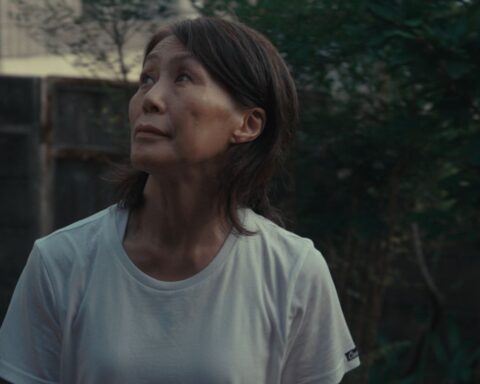The Walk
(UK/USA/Macedonia, 80 min.)
Dir. Tamara Kotevska
Section: Kaleidoscope Competition (World Premiere)
Meet Amal. She is a 10-year-old child refugee who, after escaping the war-torn terrors of Syria, is longing for a new home. She is one of over 14 million children who are unaccompanied in their journeys, leaving their health and safety at risk as they traverse countries across the Middle East and central Europe. At times, Amal is welcomed on her journey with open arms. Other times, she is met with xenophobic violence and ignorance. In many ways, her story is the quintessential immigrant experience. There’s just one difference: Amal is a puppet.
Moreover, Amal is not just a puppet, but a towering 12-foot-tall puppet operated by four people. She is the centerpiece of “The Walk,” a work of traveling performance art that aims to bring a new element of humanity to the public perception of refugees. She may be as tall as a house and made of carbon fibre, but her eyes are as wide as any ordinary child. Her streamers of hair flow in the wind, her eyes blink and wander with curiosity, her feet move one goose-step at a time. As she raverses major cities across the globe, onlookers witness not just a towering artistic achievement, but a wondrous symbol for kindness and empathy. Amal may not be a real person, but she could not be more real.
Then again, a part of her is real. After all, The Walk – the latest documentary from Honeyland director Tamara Kotevska following Amal’s journey – doesn’t actually begin with Amal. It begins with Asil, a real-world child immigrant who, after losing her family in the war, is relocated to a childcare facility in Turkey. Stuck there until her family is found, Asil begins to grow lonely and detached from the world. However, hope is reignited when she learns of “The Walk” through a security guard’s television set.
Described by accomplished stage director Amir Nizar Zuabi as “an 8000-kilometer-long rolling festival of shared humanity,” Asil instantly sees herself in Amal. Then, suddenly, she is Amal. Through voiceover narration and semi-dramatized interstitials, Asil’s longing for a new home is figuratively characterized through Amal’s real-life 5000 mile journey from Turkey to France. As we watch the highlights of Amal’s pilgrimage across the globe, we witness firsthand the mindset of an immigrant being molded as they are first exposed to the realities of immigration.
This unique framing device sets The Walk apart from any other documentary about the refugee crisis. Any filmmaker could ordinarily funnel this staggeringly unique piece of art through a behind-the-scenes puff piece, and maybe even overstuff that with an expository primer on the refugee crisis, Kotevska understands that an installation that goes this far beyond description deserves a similarly spiritual cinematic treatment. Kotevska spends little time providing context for the “The Walk” – an archival interview clip here, a shot of designing the puppet there – but it’s just enough for your interest to be piqued. Before you know it, you’re walking with Amal through Turkey surrounded by crowds of children in awe at her grandeur.
Kotevska knows that for one to get a proper understanding of Amal and “The Walk,” they simply need to experience it for themselves. By keeping the camera at a ground level, Kotevska, director of photography Jean Dakar, and cinematographer Samir Ljuma immediately instill a sense of wonder into Amal’s presence, the wonder that made her a symbol for hope amidst global crisis. It also makes harrowing scenes seem even more inescapable, such as violent counter protests and waves of homeless refugees taking refuge in camping tents under concrete.
Kotevska sprinkles in additional elements amongst the main storyline, including flashes back to Asil as well as a spotlight on two of Amal’s puppeteers, Fidaa and Mouaiad. The two are fellow immigrants, from Palestine and Syria respectively, whose stories fuel their passion for operating Amal city to city. Supplementing the story with these additional perspectives only adds to the mosaic that Amal represents, but it also makes up for the fact that the film doesn’t put the character’s literal puppetry in focus. Handspring Puppet Company has made something truly remarkable, a body puppet as ergonomic as she is expressive. Kotevska captures her with incredible majesty and empathy with poetic camerawork, yet, aside from a few shots in the beginning, those hoping to learn how her look was designed will be disappointed. However, instead, the artists are intrinsically a part of the film’s greater political aims, and as such feel like essential pieces of Kotevska’s puzzle despite initially seeming tangential.
Anyone who saw Kotevska’s previous film, the immaculate Honeyland, knows of the filmmakers’ ability to masterfully blend real-world characters with fiction storytelling techniques, but The Walk is more than just an extension of this practice. Not only does Kotevska pace a narrative that’s coherent, if standard by design, around a wide-spanning global event, but she effectively taps into the essence behind Amal’s very conception. Zuabi and the team behind theater company Good Chance designed “The Walk” as a way for the world to open their hearts to child refugees and even challenge perceptions.
It’s fitting, then, that The Walk uses its structural conceit to give voice to these refugees in ways only a film can. It is for this reason that, despite its lack of observational polish leaves it feeling less immersive in comparison to Honeyland, The Walk ultimately feels like a greater achievement. Its singular vision and impressive execution makes it a documentation worthy of Amal’s immense profundity.













